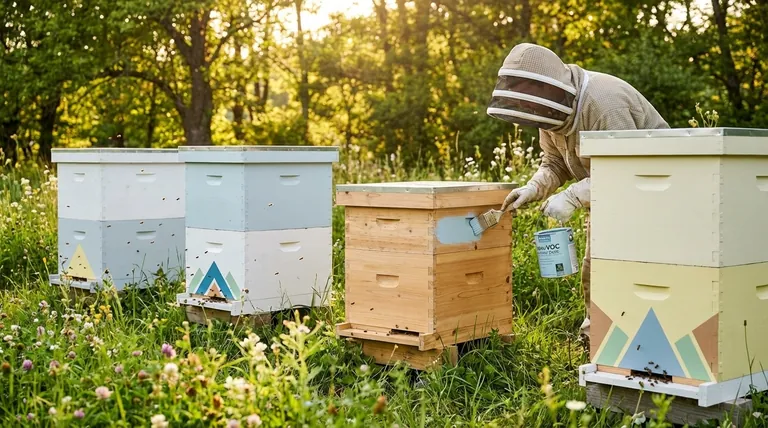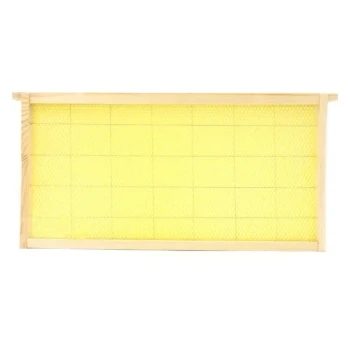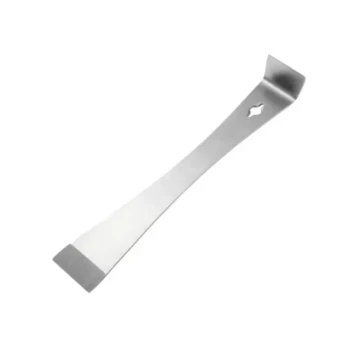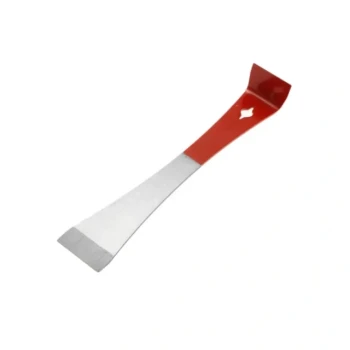At its core, painting a beehive is a critical maintenance task that serves two primary functions: protecting the wooden hive components from weather-related degradation and helping to regulate the internal environment for the well-being of the honey bee colony. It directly extends the life of your equipment and supports the health of your bees.
Painting is not a cosmetic choice; it is a fundamental practice in beekeeping. It acts as a shield for the hive's wooden structure against the elements while also providing tangible benefits to the colony, such as temperature regulation and navigational aid.

The Primary Goal: Protecting Your Investment
A beehive is a significant investment in both time and money. Proper protection is essential for ensuring its longevity.
Shielding Wood from the Elements
Unpainted wood, especially softer woods like pine commonly used for hives, is highly susceptible to moisture. Rain, snow, and humidity cause the wood to absorb water, leading to rot, warping, and structural failure over time.
A quality coat of exterior paint creates an impermeable barrier. This seal prevents moisture from penetrating the wood, effectively stopping the cycle of decay before it can begin.
Extending the Lifespan of Hive Components
By protecting the wood from rot and sun damage, you dramatically increase the functional lifespan of your hive boxes, bottom boards, and covers.
A well-painted hive can last for many years, or even decades, with minimal upkeep. This reduces the long-term cost of beekeeping and the labor required to replace or repair damaged equipment.
Supporting a Healthy Bee Colony
Beyond protecting the wood, painting directly impacts the health and productivity of the bees inside.
Regulating Internal Temperature
Bees must work to maintain a stable temperature within the brood nest (around 95°F or 35°C). In hot climates, this requires significant energy expenditure for fanning and water evaporation to cool the hive.
Using a light-colored paint reflects sunlight and reduces solar heat absorption. This keeps the hive cooler in the summer, lessening the thermal stress on the colony and allowing the bees to focus more energy on foraging and brood-rearing.
Reducing Bee "Drift"
"Drift" is the term for when bees accidentally return to the wrong hive in a densely packed apiary. This can lead to the spread of pests like Varroa mites and diseases between colonies.
Painting hives in different colors or adding unique patterns near the entrances helps returning foragers orient themselves to their correct home. This simple visual cue significantly reduces drift and promotes a healthier apiary.
Critical Painting Best Practices
How you paint is just as important as why you paint. Following a few key rules ensures you are helping, not harming, your bees.
What to Paint (and What to Avoid)
You should only paint the exterior surfaces of the hive that are exposed to weather.
Crucially, never paint the inside of the hive. The interior should be left as bare wood. Painting the inside can trap moisture, leading to mold, and may introduce chemicals or VOCs (volatile organic compounds) directly into the bees' living space.
Choosing the Right Paint
Always use a low-VOC or zero-VOC, exterior-grade, water-based latex paint. These paints are durable against the weather but are safer for the bees once fully cured, as they release fewer harmful chemicals into the air.
Making the Right Choice for Your Goal
Apply these principles to align your painting strategy with your beekeeping objectives.
- If your primary focus is maximum equipment longevity: Apply at least two coats of a high-quality exterior latex paint to all external hive components, paying special attention to joints and end grain.
- If your primary focus is colony health and productivity: Choose light colors like white, yellow, or light blue to reflect heat, and use distinct patterns near the entrance to help bees navigate home.
- If your primary focus is efficiency and safety: Always use low-VOC paint and complete all painting well before introducing bees to allow the paint to cure completely.
Properly painting your hive is a simple, proactive step that pays long-term dividends for both you and your bees.
Summary Table:
| Purpose | Key Benefit | Best Practice |
|---|---|---|
| Protect Wood | Prevents rot, warping, and decay from moisture. | Use exterior-grade latex paint on exterior surfaces only. |
| Regulate Temperature | Light colors reflect sun, reducing heat stress on bees. | Paint hives white, yellow, or light blue. |
| Reduce Bee Drift | Helps foragers identify their hive, preventing disease spread. | Use unique colors/patterns near the entrance. |
| Ensure Safety | Protects bees from harmful chemicals. | Use low-VOC or zero-VOC paint; never paint the interior. |
Ready to protect your apiary investment and support your bees' health? HONESTBEE supplies durable, high-quality beekeeping equipment and wholesale supplies to commercial apiaries and distributors. Let us help you build a stronger, more productive operation. Contact our team today to discuss your needs and request a quote!
Visual Guide

Related Products
- Langstroth Bee Hives Bee Keeping Box for Beginners Beekeeping
- Wholesales Dadant Size Wooden Bee Hives for Beekeeping
- HONESTBEE Professional Long Handled Hive Tool with Precision Cutting Blade
- Multi-Functional Sliding Hive Entrance for Beekeeping
- Long Langstroth Style Horizontal Top Bar Hive for Wholesale
People Also Ask
- Why might a beginner be advised to start with a Langstroth hive? Unlock a Supportive Beekeeping Ecosystem
- How does the orientation of the hive sides benefit comb construction? Ensure Straight, Movable Combs for Easier Hive Management
- What basic equipment is needed to start beekeeping? Your Essential Guide to a Confident Start
- What is the best type of bee hive for beginners? Start with the Proven Langstroth Standard
- Should a beginner try a different type of hive? Start with a Langstroth for a solid foundation.



















